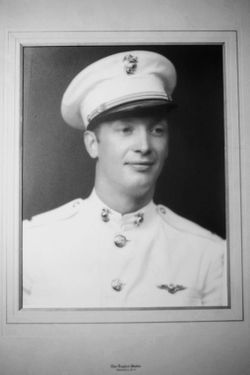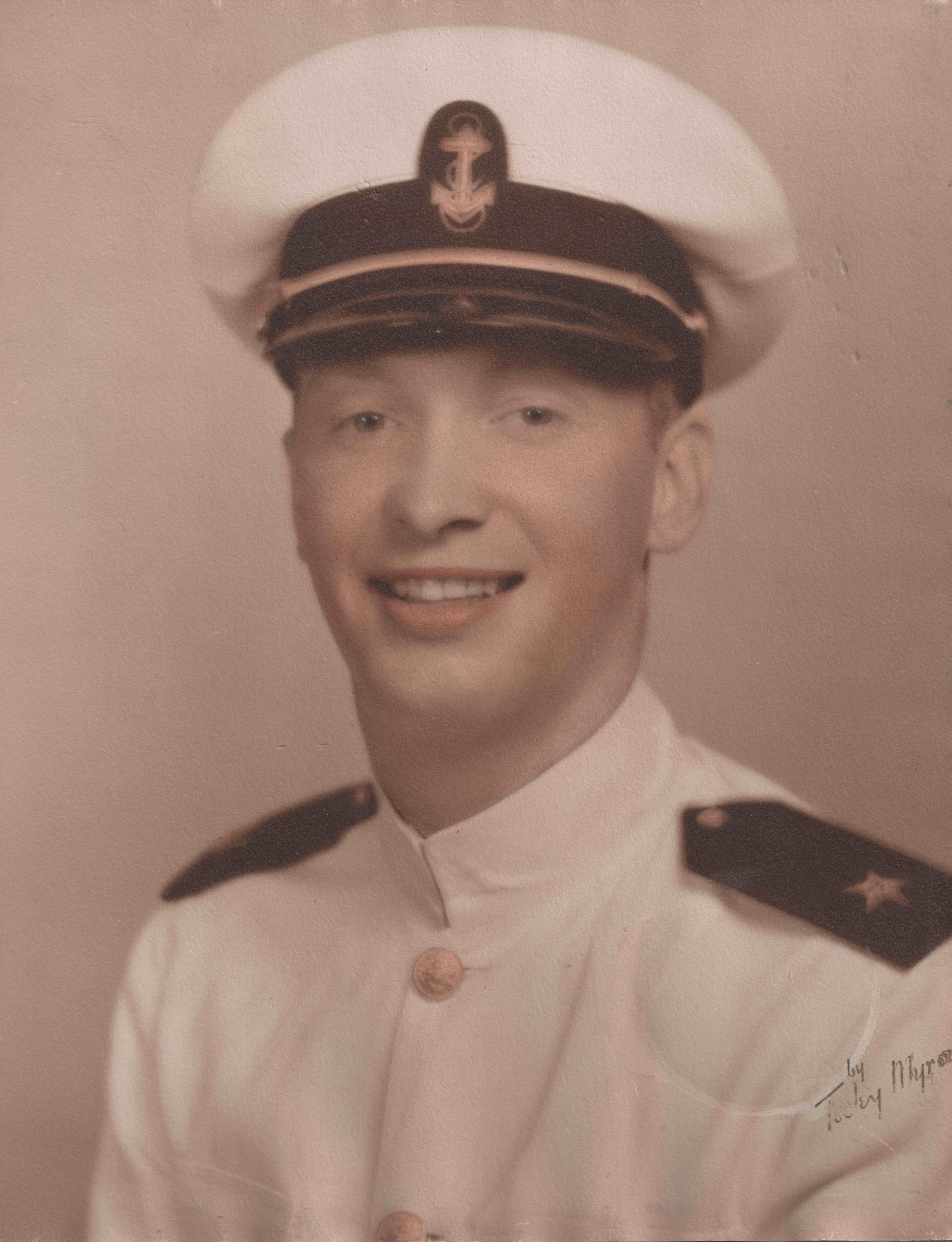Bernard continued to seek adventure and applied for entry to the Navy Air Corps. He was ordered to an “Elimination Flight Training Course,” a one-month assessment at the Naval Air Station in Squantum, MA. His next assignment was to the Naval Air Station at Pensacola where he was discharged from the Navy to transfer to the Marine Corps Reserve (USMCR) as an Aviation Cadet. The portrait to the right dates from this time. Bernard was later selected for advance flight training at the Naval Air Station in Miami and was commissioned a Second Lieutenant, USMCR at the end of April 1942. The last time his family saw Bernard was during his extended leave in late spring. From Hornell, he traveled cross country to the Naval Air Station in San Diego. He and his fiancé were married there on June 25, 1942. They were separated the following day when Bernard’s squadron left for Pearl Harbor.
Bernard had been assigned to Marine Scout Bombing Squadron 232 (VMSB-232), a unit of Marine Aviation Group 23 (MAG-23). The MAG-23 scout bombing squadrons had just been equipped with new aircraft, the Douglas SBD Dauntless, a two-seater dive bomber, on which Bernard trained intensively in July. On Aug. 2, his squadron and aircraft were shipped out on the USS Long Island, and headed toward Guadalcanal, code name “Cactus.” The pilots of VMSB-232 and its sister fighter squadron, VMF-223, were the first combat aviators to land on the Guadalcanal airstrip after its surrounding area was occupied by allied forces that had come ashore in an amphibious landing operation, code name “Operation Watchtower.” Eventually named Henderson Field, the airstrip became the base for the “Cactus Air Force” whose primary mission was to prevent the Japanese from retaking it so that it would remain a U.S. asset in the strategy to defeat the enemy.
Bernard flew over the sea and islands to bomb Japanese naval and ground targets. The flight log book for C.B. McAllister shows that in the 18 days he was on that island, Bernard flew at least 13 missions. He must have flown many more because the log was not kept consistently; 7 days in August are blank, yet other sources show he flew during that period. Sources also report that Cactus pilots were fatigued from long flying hours, both for missions and for moving their planes off the airstrip to protect them from near daily bombings by the enemy. They also suffered from lack of sleep due to nightly bombardments from off-shore enemy ships. On Sept. 6, Bernard piloted one of eleven bombers on a mission to Gizo Bay. He and another pilot and their aircrew failed to return from that mission and were declared MIA – “lost in heavy weather.” A year later, they were officially declared KIA. Bernard was posthumously promoted to Captain and was awarded the Purple Heart.
Prepared by niece mmcallister. Major sources include The Cactus Air Force, by Thomas G. Miller Jr. 1969, and related website maintained by David Hanson; Guadalcanal diary by Richard Tregaskis, 1943; family letters; flight log book of C.B. McAllister.
--------------
He also has another memorial here.
Bernard continued to seek adventure and applied for entry to the Navy Air Corps. He was ordered to an “Elimination Flight Training Course,” a one-month assessment at the Naval Air Station in Squantum, MA. His next assignment was to the Naval Air Station at Pensacola where he was discharged from the Navy to transfer to the Marine Corps Reserve (USMCR) as an Aviation Cadet. The portrait to the right dates from this time. Bernard was later selected for advance flight training at the Naval Air Station in Miami and was commissioned a Second Lieutenant, USMCR at the end of April 1942. The last time his family saw Bernard was during his extended leave in late spring. From Hornell, he traveled cross country to the Naval Air Station in San Diego. He and his fiancé were married there on June 25, 1942. They were separated the following day when Bernard’s squadron left for Pearl Harbor.
Bernard had been assigned to Marine Scout Bombing Squadron 232 (VMSB-232), a unit of Marine Aviation Group 23 (MAG-23). The MAG-23 scout bombing squadrons had just been equipped with new aircraft, the Douglas SBD Dauntless, a two-seater dive bomber, on which Bernard trained intensively in July. On Aug. 2, his squadron and aircraft were shipped out on the USS Long Island, and headed toward Guadalcanal, code name “Cactus.” The pilots of VMSB-232 and its sister fighter squadron, VMF-223, were the first combat aviators to land on the Guadalcanal airstrip after its surrounding area was occupied by allied forces that had come ashore in an amphibious landing operation, code name “Operation Watchtower.” Eventually named Henderson Field, the airstrip became the base for the “Cactus Air Force” whose primary mission was to prevent the Japanese from retaking it so that it would remain a U.S. asset in the strategy to defeat the enemy.
Bernard flew over the sea and islands to bomb Japanese naval and ground targets. The flight log book for C.B. McAllister shows that in the 18 days he was on that island, Bernard flew at least 13 missions. He must have flown many more because the log was not kept consistently; 7 days in August are blank, yet other sources show he flew during that period. Sources also report that Cactus pilots were fatigued from long flying hours, both for missions and for moving their planes off the airstrip to protect them from near daily bombings by the enemy. They also suffered from lack of sleep due to nightly bombardments from off-shore enemy ships. On Sept. 6, Bernard piloted one of eleven bombers on a mission to Gizo Bay. He and another pilot and their aircrew failed to return from that mission and were declared MIA – “lost in heavy weather.” A year later, they were officially declared KIA. Bernard was posthumously promoted to Captain and was awarded the Purple Heart.
Prepared by niece mmcallister. Major sources include The Cactus Air Force, by Thomas G. Miller Jr. 1969, and related website maintained by David Hanson; Guadalcanal diary by Richard Tregaskis, 1943; family letters; flight log book of C.B. McAllister.
--------------
He also has another memorial here.
Bio by: mmcallister
Gravesite Details
Entered the service from New York.
Family Members
Sponsored by Ancestry
Advertisement
Advertisement











